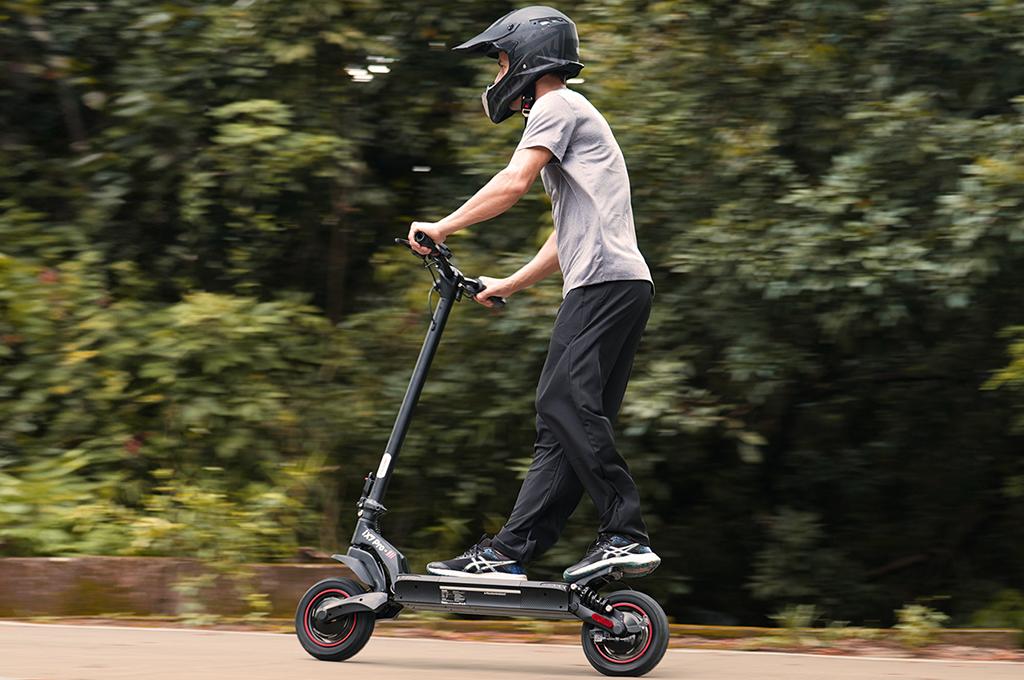Understanding Electric Scooter Speed Limitations
Before diving into modifications, it’s important to understand why electric scooters have speed limits and how they work. An electric scooter’s speed is determined by several key components:
- Battery: Provides the power (voltage and capacity) to drive the motor.
- Motor: Converts electrical energy into mechanical power, with wattage (e.g., 250W, 500W) influencing speed and torque.
- Controller: Regulates power flow from the battery to the motor, often with a speed limiter.
- Throttle: Sends signals to the controller to control speed.
- Firmware/Software: Many scooters have electronic speed caps set by the manufacturer to comply with local laws or ensure safety.
- Weight and Aerodynamics: The rider’s weight, cargo, and riding posture affect speed.
- Tires and Maintenance: Tire pressure and mechanical condition impact efficiency and performance.
Manufacturers often limit speeds to comply with regulations (e.g., 15.5 mph/25 km/h in many European countries) or to extend battery life and ensure safety. Increasing speed may involve bypassing these limits or upgrading components, but it can strain the scooter’s systems, reduce range, and void warranties.
Methods to Make Your Electric Scooter Faster
Below are the most effective methods to increase your electric scooter’s speed, ranging from simple adjustments to advanced modifications. Always check your local laws and manufacturer’s warranty terms before proceeding, as some changes may be illegal or void your warranty.

1. Optimize Basic Maintenance for Better Performance
Proper maintenance can improve efficiency, allowing your scooter to reach its maximum designed speed without modifications.
Steps:
- Check Tire Pressure: Underinflated tires increase rolling resistance, slowing the scooter. Inflate tires to the manufacturer’s recommended PSI (usually printed on the tire sidewall, e.g., 40–50 PSI for pneumatic tires). Use a reliable pressure gauge and pump.
- Clean and Lubricate Moving Parts: Dirt or debris in the wheels, bearings, or chain (for chain-driven scooters) can reduce efficiency. Clean the scooter with a damp cloth and lubricate bearings or chains with appropriate grease or lubricant.
- Inspect Brakes: Dragging brakes can slow the scooter. Ensure brake pads or calipers aren’t rubbing against the wheel or disc. Adjust or replace them if needed.
- Reduce Weight: Remove unnecessary accessories (e.g., heavy bags, lights) and minimize carried weight to reduce strain on the motor.
- Maintain Battery Health: Charge the battery fully after each use, avoid deep discharges, and store it in a cool, dry place to maintain optimal power output.
Impact:
- Increases speed by reducing friction and improving efficiency.
- Can add 1–3 mph (1.6–4.8 km/h) to top speed in some cases.
- Safe and legal, with no warranty risks.
Tools Needed:
- Tire pressure gauge and pump.
- Cleaning supplies and lubricant.
- Basic toolkit for brake adjustments.
2. Adjust or Disable Speed Limiters (Firmware Tweaks)
Many electric scooters have electronic speed limiters set by the manufacturer’s firmware to comply with local regulations or ensure safety. Disabling or adjusting these limiters can unlock higher speeds, but it requires caution and technical knowledge.
Steps:
- Check the Manual or App: Some scooters (e.g., Xiaomi, Segway) allow speed adjustments via a mobile app or display settings. Look for options like “Sport Mode” or custom speed settings to increase the limit.
- Access Firmware Settings: For advanced users, connect the scooter to a computer or app using a compatible cable or Bluetooth. Tools like the “Xiaomi M365 Tools” app or custom firmware platforms can modify speed caps for compatible models.
- Install Custom Firmware: For brands like Xiaomi or Ninebot, custom firmware (e.g., CFW) can remove speed limits and increase power output. Research forums like Electric Scooter Forum or Reddit for model-specific guides.
- Test Safely: After adjusting the firmware, test the scooter in a safe, open area to ensure stability at higher speeds.
Impact:
- Can increase speed by 5–10 mph (8–16 km/h), depending on the scooter’s motor and battery.
- Improves acceleration in some cases.
Risks:
- Voids warranty in most cases.
- May overheat the motor or controller, reducing lifespan.
- Illegal in many regions if the scooter exceeds local speed limits (e.g., 15.5 mph/25 km/h in the EU, 20 mph/32 km/h in some U.S. states).
- Requires technical expertise to avoid damaging the scooter.
Tools Needed:
- Smartphone or computer with compatible app/software.
- USB cable or Bluetooth connection (model-specific).
- Backup of original firmware (recommended).
Precautions:
- Research your scooter’s model thoroughly before modifying firmware.
- Ensure the motor and controller can handle increased power demands.
- Check local laws to avoid fines or confiscation.
3. Upgrade the Battery
A more powerful battery can deliver higher voltage or capacity, increasing the scooter’s speed and torque. However, this is a complex modification that requires compatibility with the motor and controller.
Steps:
- Check Current Battery Specs: Find your scooter’s battery voltage (e.g., 36V, 48V) and capacity (Ah) in the manual or on the battery label.
- Select a Compatible Battery: Choose a battery with higher voltage (e.g., upgrading from 36V to 48V) or capacity (e.g., 10Ah to 15Ah) that matches your scooter’s motor and controller specifications. Consult the manufacturer or a technician.
- Replace the Battery: Disconnect the old battery, install the new one, and secure all connections. Ensure proper insulation to prevent short circuits.
- Update the Controller: A higher-voltage battery may require a compatible controller to handle the increased power.
- Test the Scooter: Charge the new battery fully and test in a safe area to confirm performance.
Impact:
- Can increase speed by 5–15 mph (8–24 km/h), depending on the upgrade.
- Improves range and acceleration.
Risks:
- Expensive (new batteries cost $100–$500).
- Voids warranty and may damage the motor or controller if incompatible.
- Illegal if the scooter exceeds local power or speed limits.
- Requires professional installation for safety.
Tools Needed:
- Replacement battery (model-specific).
- Screwdrivers, wrenches, and wire cutters/strippers.
- Multimeter to check voltage and connections.
Precautions:
- Verify compatibility with a professional or the manufacturer.
- Use a fireproof bag or enclosure for lithium-ion batteries to prevent fire risks.
- Dispose of the old battery responsibly at a recycling center.
4. Upgrade the Motor
A more powerful motor (higher wattage) can significantly increase speed and torque, but it’s one of the most complex and costly modifications.
Steps:
- Check Current Motor Specs: Identify your scooter’s motor wattage (e.g., 250W, 500W) and type (brushed or brushless). This is usually in the manual or on the motor itself.
- Select a Compatible Motor: Choose a motor with higher wattage (e.g., 750W or 1000W) that fits your scooter’s frame and is compatible with the battery and controller.
- Replace the Motor: Remove the existing motor (typically in the wheel hub or under the deck) and install the new one. This may require wheel replacement for hub motors.
- Upgrade the Controller: A more powerful motor often requires a new controller to handle increased power demands.
- Test Thoroughly: Ensure all connections are secure and test the scooter at low speeds to confirm stability.
Impact:
- Can increase speed by 10–20 mph (16–32 km/h), depending on the motor.
- Enhances hill-climbing ability and acceleration.
Risks:
- Very expensive ($200–$600 for motor and controller).
- Voids warranty and may strain other components (e.g., battery, frame).
- Illegal if exceeding local power limits (e.g., 750W in some U.S. states).
- Requires advanced technical skills or professional installation.
Tools Needed:
- Replacement motor and controller.
- Toolkit (screwdrivers, wrenches, Allen keys).
- Multimeter for electrical testing.
Precautions:
- Ensure all components (battery, controller, motor) are compatible.
- Consult a professional for installation to avoid damage.
- Check local regulations for motor power limits.
5. Improve Aerodynamics and Reduce Weight
Reducing drag and weight can improve speed by making the scooter more efficient.
Steps:
- Optimize Riding Posture: Lean forward slightly while riding to reduce wind resistance. Avoid upright positions that create drag.
- Remove Unnecessary Accessories: Detach heavy or bulky items like baskets, extra lights, or phone mounts.
- Use Lightweight Materials: Replace heavy components (e.g., handlebars, deck) with lightweight alternatives like carbon fiber or aluminum, if available.
- Upgrade Tires: Switch to slick or semi-slick tires designed for lower rolling resistance, if compatible with your scooter.
Impact:
- Adds 1–5 mph (1.6–8 km/h) to top speed, depending on conditions.
- Improves battery efficiency and range.
Risks:
- Minimal, but lightweight materials can be costly.
- Slick tires may reduce traction on wet or uneven surfaces.
Tools Needed:
- Replacement tires or lightweight components (optional).
- Basic toolkit for accessory removal.
Precautions:
- Ensure replacement parts are compatible with your scooter.
- Test new tires in a safe area to confirm handling.
6. Increase Voltage with a Booster
A voltage booster or “overvolting” involves adding a device to increase the voltage supplied to the motor, boosting speed.
Steps:
- Research Compatibility: Confirm your scooter’s motor and controller can handle higher voltage (e.g., boosting from 36V to 48V).
- Purchase a Booster: Buy a voltage booster compatible with your scooter’s electrical system.
- Install the Booster: Connect the booster between the battery and controller, following the manufacturer’s instructions.
- Test Safely: Start at low speeds to ensure the system handles the increased voltage.
Impact:
- Can increase speed by 5–10 mph (8–16 km/h).
- Improves acceleration.
Risks:
- High risk of overheating or damaging the motor and controller.
- Voids warranty and may reduce component lifespan.
- Illegal if exceeding local power or speed limits.
Tools Needed:
- Voltage booster device.
- Electrical toolkit (wire cutters, connectors, multimeter).
Precautions:
- Consult a professional electrician or technician.
- Monitor the scooter for overheating during use.
7. Switch to a Higher-Performance Mode
Many scooters have multiple riding modes (e.g., Eco, Standard, Sport) that limit speed to save battery or comply with regulations. Switching to a higher-performance mode can unlock the scooter’s full potential.
Steps:
- Check the Manual: Look for instructions on switching modes via the display, buttons, or a mobile app.
- Select Sport Mode: Use the mode button (often a double-tap or long press) or app to switch to the highest-performance mode.
- Test the Scooter: Ride in a safe area to confirm the speed increase.
Impact:
- Can increase speed by 3–10 mph (4.8–16 km/h), depending on the model.
- Safe and legal if the mode is built into the scooter.
Risks:
- Reduces battery range due to higher power consumption.
- May not be available on all models.
Tools Needed:
- None, or a smartphone for app-based scooters.
Precautions:
- Ensure the scooter is stable at higher speeds.
- Check local speed limit regulations.
Safety Precautions
Increasing your scooter’s speed can make it less stable and harder to control, especially at high speeds. Follow these precautions:
- Wear Safety Gear: Always wear a helmet, knee pads, elbow pads, and reflective clothing.
- Test in a Safe Area: Try modifications in an open, flat area free of traffic and obstacles.
- Check Brakes: Ensure brakes are capable of stopping the scooter at higher speeds. Upgrade to disc brakes or larger pads if needed.
- Monitor Heat: High speeds can overheat the motor, controller, or battery. Stop and let the scooter cool if it feels hot.
- Inspect Regularly: Check for loose bolts, worn tires, or damaged components after modifications.
Legal Considerations
Before modifying your scooter, research local laws, as exceeding speed or power limits can result in fines, confiscation, or legal penalties. Common regulations include:
- Speed Limits: Many regions cap electric scooter speeds at 15.5 mph (25 km/h, EU) or 20 mph (32 km/h, some U.S. states).
- Power Limits: Motor power is often limited (e.g., 250W in the UK, 750W in California).
- Road Usage: Some areas prohibit scooters on public roads or require registration for high-powered models.
- Age Restrictions: Riders under a certain age (e.g., 16) may face restrictions.
Check with your local Department of Motor Vehicles or equivalent authority to ensure compliance.
Alternatives to Modification
If modifications are too risky or costly, consider these alternatives:
- Buy a Faster Scooter: Purchase a high-performance model like the Dualtron Thunder (50 mph/80 km/h) or Apollo Phantom, designed for speed within legal limits.
- Optimize Riding Conditions: Ride on flat, smooth surfaces to maximize speed and efficiency.
- Use Downhills: Take advantage of downhill slopes to boost speed naturally (within safe limits).
Conclusion
Making your electric scooter faster is achievable through maintenance, firmware tweaks, battery or motor upgrades, aerodynamic improvements, or mode adjustments. However, each method carries risks, including voided warranties, reduced lifespan, and legal issues. Start with simple, low-risk options like optimizing tire pressure or switching to Sport Mode before attempting complex modifications like battery or motor upgrades. Always prioritize safety by wearing gear, testing in controlled environments, and ensuring brakes can handle higher speeds. Check local laws to avoid penalties, and consider professional assistance for technical modifications. With careful planning, you can enhance your scooter’s performance and enjoy a faster, more exhilarating ride while staying safe and legal.



